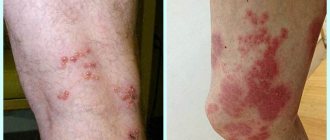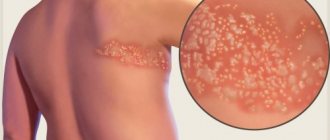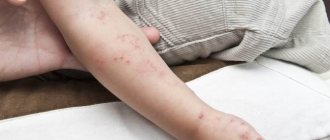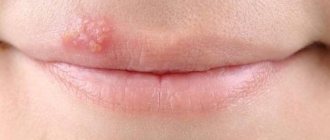First of all, it should be borne in mind that the so-called herpes in the mouth is the common name for herpetic stomatitis (a disease also caused by the herpes simplex virus, but significantly different from the common cold on the lips for many).
Herpetic stomatitis is not a rare disease, and millions of people around the world suffer from it, sometimes several times a year. Most often children, less often adults. We will talk about the reasons for this age specificity a little further below.
The appearance of herpetic rashes in a child’s mouth becomes a cause for concern for a huge number of parents. This is not surprising: when a child experiences pain for several days in a row due to ulcers in the mouth, he often cries, refuses to eat, and often the disease also manifests itself as a characteristic infectious-toxic syndrome with an increase in body temperature and severe general malaise.
The photo below shows what damage to the mucous membranes in a child’s mouth (herpetic stomatitis) may look like:
Few people went through their childhood without such trouble, and few parents did not have to notice such white spots in their child’s mouth.
Note: in rare cases, herpetic stomatitis in children can be severe, with a strong deterioration in the patient’s condition and a non-standard set of symptoms. In such cases, the disease can be difficult to differentiate from other inflammatory diseases of the oral cavity, which are sometimes quite dangerous and fraught with serious consequences. Therefore, only a doctor should carry out such a diagnosis, and even more so, choose how to treat the disease when it is severe. The task of parents is to detect signs of the disease as early as possible and make a timely decision to visit a doctor if symptoms increase.
Types of herpetic stomatitis
In the vast majority of cases, herpes infection of the mucous membranes in the mouth develops and occurs in an acute form, with an abrupt onset, rapid manifestation of symptoms and their rapid completion. Therefore, in medical practice the disease itself is usually called acute herpetic stomatitis.
The chronic form is more rare and develops mainly in adults with various pathologies of the immune system (most doctors classify chronic herpetic stomatitis specifically as diseases of the immune system). The disease can also develop due to congenital or acquired immunodeficiency. Chronic herpetic stomatitis is characterized by constant relapses of varying degrees of severity, often turning into one another. Treating chronic stomatitis is very difficult.
Acute herpetic stomatitis is divided into three types according to severity:
- Mild is the most common and is typical for primary infection of a healthy, immunocompetent person. It proceeds quickly, and the symptoms of intoxication are relatively mild. The disease ends without consequences, and may recur in the future when the immune system is weakened;
- Moderate - also ends quickly, but occurs with a pronounced toxic syndrome;
- Severe - relatively rare, develops, as a rule, in weakened children, is very difficult and is often complicated by associated infections. Requires hospitalization of the patient and constant monitoring by a doctor.
How severely herpes manifests itself depends not on the pathogen, but on the state of the body and the human immune system as a whole. The severity of the disease is often influenced by the presence of any other somatic disease in the patient.
Complications
Herpes in the mouth can cause serious complications:
- viral stomatitis;
- pharyngitis;
- viral infection of the esophagus;
- viral infection of the digestive system;
- eye diseases - herpetic conjunctivitis, iridocyclitis, keratitis (in the latter case, clouding of the cornea may develop);
- diseases of the central and peripheral nervous system. The most dangerous is viral encephalitis. Involvement of the meninges in the pathological process leads to the development of viral meningitis;
- urogenital pathology;
- herpetic pneumonia;
- viral damage to joints and kidneys;
- generalized viral damage is the most severe complication. In this case, a person develops severe viral damage to all organs and systems.
Herpes in the mouth can cause eye diseases - herpetic conjunctivitis, iridocyclitis, keratitis (in the latter case, clouding of the cornea may develop).
Chronic recurrent herpes
This is the most common type of herpes infection. The disease can manifest at any age. The following factors provoke the disease:
- trauma to the oral mucosa;
- intense sun exposure;
- eating disorder.
The severity of clinical symptoms of chronic herpes can be much lower than with acute infection. With relapses, small ulcers or rashes appear on the mucous membranes of the mouth, tongue or lips. A person feels a slight burning sensation, itching, and sometimes slight pain. If the lesion occurs in the same area, then fixed herpes is diagnosed.
The severity of clinical symptoms of chronic herpes can be much lower than with acute infection. With relapses, small ulcers or rashes appear on the mucous membranes of the mouth, tongue or lips.
This disease must be differentiated from:
- aphthous stomatitis (recurrent);
- allergic stomatitis;
- Streptococcal impetigo.
Treatment of chronic recurrent herpes is carried out using the same drugs as for acute infection. Medicines containing interferon are indicated.
To improve the condition of the body, you should take general strengthening, immunomodulating drugs.
Recurrent herpes requires long-term treatment and compliance with all recommendations, then a sharp deterioration in health can be avoided.
Causes of the disease
For the first time in life, herpes almost always develops during the primary infection of the body with the herpes simplex virus type 1. By the way, the same pathogen causes colds on the lips and some rarer diseases.
As a rule, infection with the virus occurs from another person through airborne droplets, household or contact. Sometimes it is enough to communicate once with a person who has symptoms of a cold on the lips for viral particles to enter the mouth of a healthy person. If a person has never had herpes before, and therefore does not have immunity to it, the virus will not meet sufficient resistance from the body’s immune system, will gain a foothold in the epithelium of the mucous membranes of the mouth and will lead to the development of herpetic stomatitis.
Infection is also possible through the use of shared utensils, toiletries and personal hygiene products, and through bodily contact. A child can become infected with the virus, including from their parents.
Note: according to statistics, about 80% of cases of herpetic mouth ulcers occur in children aged 1-4 years. Rarely, children up to six months old can get sick, and only in about 2-3% of cases does herpes stomatitis develop in people over 50 years of age.
During primary infection, the virus multiplies in large quantities in the mucous membranes of the mouth. The cells into which the virions invade and begin to produce new particles die and infect neighboring cells. Inflammation develops in this place, and a small whitish bubble with liquid appears above it. This liquid contains a huge number of viral particles.
The photo shows traces of damage to the oral mucosa due to herpetic stomatitis:
Ulcers with herpetic stomatitis are not always similar to the papules that appear with herpes on the lips. Stomatitis blisters are often whitish, flat, and larger.
Quite quickly after the initial infection of the body, individual virions penetrate the processes (axons) of nerve cells that innervate the oral mucosa. The particles “roll down” along the axons to the cell nucleus, located in the spinal cord, and insert their DNA into the DNA of the nerve cell. After this, throughout a person’s life, the nerve cell will regularly produce new viral particles.
It would seem that since the nerve cells of the spinal cord constantly produce the herpes simplex virus, therefore, a person is doomed to suffer from the corresponding disease throughout his life? Fortunately, it's not all bad.
The body's immune system forms a set of antibodies and other agents that successfully destroy all herpes viral particles outside the nerve cells. The body develops immunity, and it is continuously maintained due to the constant suppression of virions.
By the way, it is also useful to read:
- Treatment of herpes on the tongue: from symptoms and diagnosis to specific medications
- If herpes is localized in a child’s throat: how to treat it correctly?
All new virions are destroyed as soon as they leave the “mother” nerve cell. Only in the case of a severe weakening of the immune system does the body lose control over these particles, and they get a chance to exit the axons into the intercellular space and begin to infect other cells. This is how a relapse of the disease develops.
This is interesting: usually a recurrence of herpes appears in the same place where the rash was located during the initial infection. This is due to the fact that the virions are released from the same nerve cells that were initially infected. At the same time, the oral cavity and lips often innervate the same neurons, and therefore the situation is normal when the primary infection occurs through the oral cavity, and relapses appear on the lips. This explains the fact that mainly children suffer from herpetic stomatitis: the primary infection of the body occurs in childhood, and then with relapses in an adult, rashes appear more often on the lips. However, relapses of herpetic stomatitis in adulthood are also not uncommon.
The symptoms of herpetic stomatitis and the appearance of rashes in the oral cavity are somewhat different from those with herpes on the outer integument of the body. Let's take a closer look at these differences...
How to diagnose the disease
Herpes of the oral mucosa is diagnosed after examination of the oral cavity by a doctor. Ulcers with this disease have their own characteristics; a specialist will not confuse them with another virus.
Parents should learn to recognize the signs of the disease in order to understand what virus has appeared in the baby’s mouth - stomatitis or herpes.
Differences between herpes and stomatitis
Herpes in the mouth has the following distinctive features:
- swelling of a certain area of the mucosa;
- the appearance of bubbles that open over time;
- the affected area covers the periosteal structures.
Stomatitis covers the entire oral cavity, ulcers appear in the initial stages of the disease.
Clinical picture: what it looks like in practice
The photo below shows an example of herpetic papules in a child's mouth:
The main sign of the disease is several light, almost white blisters or spots that appear on the roof of the mouth, tongue, gums, or the inner surface of the cheeks and lips. Each vesicle is surrounded by a small ridge of hyperemia and is very painful (due to this pain, the child may refuse to eat, especially if it is warm).
As a rule, herpetic rashes are grouped into small clusters, located close to each other in the same area in the oral cavity.
For example, the photo shows stomatitis on the palate of an adult:
And here are the manifestations of the disease on the inside of the cheek and lower lip:
The following photo shows what herpes looks like on the tongue:
Depending on the severity of the disease, a different number of lesions (ulcers) develops:
- With a mild form of stomatitis, there are usually no more than 5 of them;
- With moderate severity - up to 20;
- In severe cases, up to 100. In these cases, the bubbles can merge into large necrotic spots.
The gradation, of course, is very arbitrary.
After the papules break through, small ulcers similar to “craters” form in their place. That is, the situation is normal when, instead of bubbles, you see slightly deepened wounds on the oral mucosa.
Sometimes the mucous membrane of the palate swells (swells) or the inner surface of the cheeks, and in severe forms of the disease, bleeding gums may develop. In the most severe cases, ulcerative gingivitis develops at the site of extensive necrotic lesions of the mucous membrane.
Prevention
The main prevention is to avoid contact with people who have herpetic rashes. Infection can be prevented by eating well and following a daily routine. People with bad habits are more susceptible to herpes on the palate.
Herpes often accompanies colds, so in order to prevent the appearance of ulcers on the palate, you need to promptly treat viral and bacterial infections.
If you receive injuries to the oral cavity, you must immediately apply topical products, otherwise the herpes infection will be activated.
Symptoms and chronology of the disease
Along with the appearance of characteristic ulcers in the mouth, herpetic stomatitis also manifests itself with a number of other symptoms. For a mild form of the disease it is:
- Sudden rise in temperature to 37°C or slightly higher;
- Painful ulcers in the mouth (which in young children may result in increased moodiness, poor sleep, and refusal to eat);
- Inflammation of the mucous membranes of the nose (rhinitis), pharyngitis;
- Hypersalivation.
At the same time, the child’s general condition is normal, he does not feel sick, plays actively and moves a lot.
As a rule, in this form the disease progresses quickly:
- After about 1-2 days, rashes develop and symptoms increase;
- After about 2 more days, the vesicles fill, break through and become covered with epithelium;
- Within 3-4 days, complete healing of all ulcers occurs and the patient’s condition normalizes.
The total duration of the disease in this case is approximately 5-8 days.
With a moderate form of herpetic stomatitis, signs of general toxicosis already appear: malaise, loss of strength, headaches, nausea. The patient's body temperature may rise to 39°C, and he is advised to rest in bed. A blood test reveals an increase in ESR (up to 20 mm/hour), lymphocytosis and plasmacytosis. Leukopenia is common, leukocytosis is more rare.
With moderate herpes in the mouth, the temperature may either decrease or rise again (if the rash develops in several stages). The course of the disease may be delayed by an additional 5-7 days compared to the mild form.
Note: the speed of complete healing of ulcers is affected by the presence of other infections in the oral cavity. In particular, ulcers on the gums can become infected and develop secondary gingivitis.
The severe form of herpetic stomatitis is manifested by the most severe symptoms:
- The temperature rises to 39-40° even before the appearance of ulcers in the oral cavity;
- The lymph nodes are enlarged, especially the submandibular and cervical ones;
- The patient develops apathy and does not want to move;
- Severe headaches, nausea, and sometimes vomiting appear;
- There is a pronounced putrid odor from the mouth;
- The heart rhythm is disturbed, bradycardia and tachycardia, arterial hypotension are diagnosed;
- Clearly expressed gingivitis develops;
- A runny nose may occur.
About a day or two after the first symptoms of the disease appear, rashes develop on the oral mucosa, numerous and painful. In addition, herpetic blisters can also appear on the lips, chin, earlobes and eyelids. Nosebleeds are often reported. In the blood there is a band shift to the left, eosinophilia and leukopenia.
The duration of manifestations of herpes in severe form depends significantly on the order of treatment and the presence or absence of complications.
Features of herpes in the mouth
Let us immediately determine that type 1 herpes is present in the body of each of us, but the infection becomes active only during a cold or weakened immune system. That’s why people call the disease a “cold.”
Often the blister appears inside the cheek, on the lips, tonsils or gums. In appearance it looks like a watery bubble , sometimes it is a series of small blood bubbles along the throat.
Let us highlight that the disease develops more often in children under five years of age; previously, they get sick less often. Because the immunity received from parents works.
Herpes on the inside of the lip may be:
- Acute , when infection with the herpes virus occurs, about 80% of patients in large groups suffer from it;
- Chronic , when blisters pop up periodically, at the time of weakening of the immune system.
If you are faced with the first form of herpes, then you need to start emergency treatment, but if you suffer from the second form, then it is important to periodically carry out prevention.
Let us highlight the forms of development of the disease :
- Mild , when bubbles appear in the mouth unnoticed, the temperature remains normal, but swelling in the oral cavity is visible. Then the entire area behind the lower lip or cheek is affected in the form of blisters. Adults are less susceptible to this phenomenon than children;
- Moderate, when the symptoms appear more clearly, but with timely treatment you can get rid of the disease completely;
- Severe when herpes spreads not only to the lips, but also to the gums and cheeks. Bubbles appear on the palate unexpectedly, and if left untreated, marks and scars may appear.
especially attentive to the appearance of herpes in the mouth , because the disease is often diagnosed too late, when it is in severe form.
Related article:
All about the disease herpes. Causes, symptoms and treatment
Herpes on the oral mucosa - video
A few words about diagnostics
In most cases, to diagnose herpetic stomatitis, a simple examination of the patient’s oral cavity is sufficient for the doctor. Herpes sores look so characteristic that they are difficult to confuse with manifestations of other diseases.
Note: as a rule, when diagnosing a disease, it is necessary to distinguish the acute from the chronic form, as well as differentiate the disease from stomatitis caused by other pathogens.
In chronic herpetic stomatitis, relapse occurs more mildly, in a “lubricated” form, without significant deterioration of the patient’s condition. Often, rashes in the mouth even turn out to be practically painless, and therefore the disease manifests itself only by visually observable manifestations.
In the acute form, the patient always feels pain with stomatitis, his body temperature rises, although it does not always go beyond subfebrile values.
Herpetic lesions differ from other forms of stomatitis mainly in the specificity of external manifestations:
- For example, with the so-called herpangina (enteroviral stomatitis), the rashes are located mainly in the pharynx. With the same disease, the condition of the sick child is very serious, he develops a severe runny nose, and the general toxic syndrome prevails over the catarrhal one. The photo below shows what the throat of a sick child with herpes sore throat looks like:
- With Vincent's stomatitis, the ulcers are located in the mouth mainly on the gums; the plaque on them is easily and painlessly removed. The very shape of the affected areas of the mucous membrane differs from the appearance of ulcers with herpes - they are large, have uneven edges, and cover large areas of the mucous membrane. An important feature of Vincent's stomatitis is that it develops mainly in young men, and children are extremely rarely affected by it;
- Aphthous stomatitis is characterized by the appearance of solitary white canker sores on the gums or tongue. They are very painful, but the general condition of the patient remains normal.
The photo shows the appearance of aphthae with aphthous stomatitis:
Traditional therapy
If herpes has just appeared on the lips or the inside of the cheeks, then you can resort to traditional medicine methods, which include :
- Applying toothpaste to a blister that has just appeared, when bacteria will not multiply and the wound will begin to dry out;
- Sprinkle a thin layer of table salt on your lip several times a day;
- Make poultices or compresses based on chopped garlic and grated apple, mix them in equal proportions, one teaspoon at a time;
- Make a compress from cooled black tea, applying gauze to the affected area for 20 minutes;
- You can lubricate the bubbles with valocordin or sage oil;
- Prepare an ointment based on walnuts and honey, which are mixed in equal proportions and applied to the blister;
Related article:
Herpetic (herpetiform) stomatitis - causes, features of the course and proper treatment.
Treatment of herpes in the mouth at home: video
Treatment for herpetic stomatitis
Treatment of herpes is difficult, primarily because the virus itself cannot be completely destroyed in the body. After infection, a person will remain a carrier of the infection for the rest of his life, and under certain conditions (decreased immunity) he may develop a relapse of the disease.
However, a specific episode of the disease requires treatment - at least to alleviate the patient’s condition.
The main component of the therapeutic complex for the treatment of herpes in the oral cavity is acyclovir-based tablets - these drugs suppress the multiplication of the virus and stop the development of the disease in the early stages. Adults and children over two years of age are usually prescribed 200 mg of acyclovir 4-5 times a day for 5 days after symptoms of the disease are detected. Children under two years of age are prescribed 100 mg with the same frequency. Herpes in the mouth can be treated with acyclovir tablets only under the supervision of a doctor.
The drug Valtrex, based on valacyclovir, is used similarly to drugs based on acyclovir (the dosage schedule is determined by the doctor individually).
There is no point in using any ointment or cream based on acyclovir, since the product will quickly be washed off with saliva and simply swallowed. It should be kept in mind that ointments used to treat colds on the lips are intended for external use only.
It makes sense to treat herpetic stomatitis with acyclovir (valaciclovir) only if the disease is quite severe.
Note: it is important to understand that there are no medications that could be used to anoint herpetic sores in the mouth at home, and all the unpleasant symptoms of the disease would immediately go away. It is quite problematic to influence a viral infection, and you certainly should not rely on various folk remedies, such as garlic or honey.
Meanwhile, for herpetic stomatitis, rinsing with antiseptic solutions is indicated - for example, special dental mouth rinses, chlorhexidine solution, Miramistin, chamomile or oak bark decoctions. Antiseptics provide protection for ulcers from bacterial infection, and therefore from possible complications of the disease (however, antiseptics do not affect the course of a viral infection).
Painkillers and anti-inflammatory drugs are sometimes used as symptomatic therapy:
- Tantum-Verde spray and its analogues;
- Special pastes, for example, solcoseryl dental adhesive paste (SDAP);
- Decoctions of herbs and plant materials that have an anti-inflammatory effect.
In severe forms of herpetic stomatitis, symptomatic treatment with the use of antipyretic drugs is indicated if the patient’s temperature rises above 38.5°C. For children, as a rule, medications based on ibuprofen (Nurofen) or paracetamol (Paracetamol, Efferalgan) are used. But Analgin or Aspirin is not recommended for use due to the risk of severe side effects (it is also not recommended for adult patients to take them).
Note: the feasibility of treating herpes with medications based on interferon or its inducers is questionable. Many doctors prescribe them as antiviral drugs, while they have no proven effectiveness and are not used anywhere except in the CIS countries.
Herpes in the mouth: causes of occurrence
We have determined when the blister appeared and what it is, but it is important to understand why this happens.
This is how the virus spreads through airborne droplets, namely:
- Through kisses and other close contact with the patient;
- Insufficient hygiene.
After entering the body, the herpes virus moves to the nerve endings, where it can remain in a passive state for decades. At the time of a cold or general loss of strength, the virus moves into the oral cavity, causing inflammation.
For activation of herpes in the oral cavity to occur, it is enough:
- Stress and strain;
- Pain syndrome;
- Operations;
- Colds;
- Increase in temperature;
- Influence of environmental factors;
- Menses;
- Autoimmune diseases;
It happens that white watery rashes form and open within 10-12 days after activation. But it is important to distinguish between the symptoms of stomatitis, which forms on the inside of the cheek when the herpes is located closer to the gums and lips.
Also, stomatitis does not have an exact location, when the herpes blisters are located in one area.
Herpes in the mouth - what it looks like: photo
Prevention of disease in children and adults
It is almost impossible to protect yourself from infection with the herpes virus: nine out of ten people with whom a child communicates are carriers of this infection, and many of them have relapses in a blurred, asymptomatic form, and it is unlikely that it will be possible to prevent the child from communicating with them. For this reason, by the age of 3-4 years, most children manage to become infected and get sick with stomatitis of a herpetic nature.
At the same time, it is quite possible to protect yourself from repeated episodes of the disease. Since they occur when the immune system is weakened, preventing relapses of herpes consists precisely in preventing such weakening.
To do this you need:
- Lead a healthy lifestyle, give up bad habits;
- Eat right, avoid synthetic foods;
- Exercise;
- Frequently spend time in the fresh air, strengthen yourself (this is especially important for a child);
- Treat any somatic diseases quickly and under the supervision of a doctor.
Practice shows that secondary relapses of herpes occur quite easily, often children do not notice them at all, and therefore, in general, there is no need to fear a recurrence of herpetic stomatitis. Moreover, there is no need to stuff your child with various immunomodulators to protect against it. A healthy lifestyle and a proper hardening system will be quite enough.
Useful video: what is important to know about acute herpetic stomatitis in children
How is the diagnosis carried out?
Diagnostic measures for identifying herpes in the mouth include several stages:
- collection of medical history;
- examination by the attending physician - a specialist determines the location of the rash, its nature and the main signs of the disease;
- performing a biopsy;
- taking a smear to identify the herpes virus, determine its type, as well as to determine sensitivity to various drugs;
- carrying out laboratory tests aimed at examining the patient’s blood - the purpose of this study is to identify the presence of antibodies to the pathogen in the blood.
which is necessary for correct diagnosis, deserves special attention It is necessary to distinguish herpes from stomatitis (not herpetic). Clinical studies have shown that there are certain differences between these pathological processes:
- Localization. Herpes in the mouth is located in one place (tongue, cheeks, gums). Stomatitis is characterized by simultaneous damage to several zones.
- Rash. After opening the herpetic blisters, ulcers remain in their place, which gradually heal. With stomatitis, there are no blisters, and ulcers appear on the mucous membrane immediately.
- Damage zone. Herpes rashes are characterized by the location of blisters near bone structures. Only then does it spread to soft tissues. Stomatitis, on the contrary, initially affects the lips and the inner surface of the cheeks.
It is important to understand that herpes in the mouth and stomatitis require a fundamentally different approach to treatment. Timely diagnosis will make the course of therapy as effective as possible.
Acute herpetic stomatitis is one of the dangerous types of stomatitis










